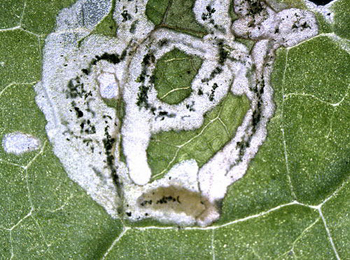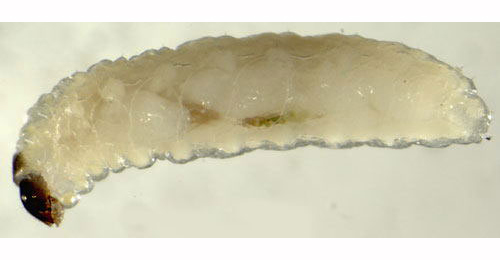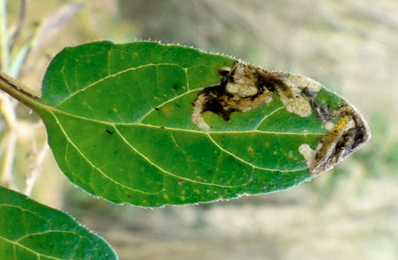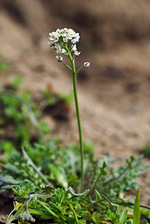|
||||||
|
TEESDALIA. Shepherd's Cress. [Brassicaceae] |
|
|
Only one species of Teesdalia, Shepherd's Cress (T. nudicaulis), is recorded in Britain. The BSBI provide a downloadable plant crib for Brassicaceae. Three British miners are recorded on Teesdalia. A key to the European miners recorded on Teesdalia is provided in Bladmineerders van Europa. |
|
|
Key for the identification of the known mines of British |
1a > Leaf-miner: Rather small, untidy, full depth, often branched corridor, often close to the leaf margin. Sides irregularly eaten out. Frass in a greyish-green central line that is interrupted from time to time, sometimes partly in strings. In times of rain the frass may run out and appear greenish. Usually several mines in a leaf. The body is whitish; head greyish brown with Y-shaped lighter marking. Pronotum with a pair of brownish shields. The mandibles have two teeth. |
 Mine of Ceutorhynchus minutus on Raphanus sativus Image: © Willem Ellis (Bladmineerders van Europa) |
 Ceutorhynchus minutus larva, lateral Image: © Willem Ellis (Bladmineerders van Europa) |
|
Ceutorhynchus minutus (Marsham, 1802) [Coleoptera: Curculionidae]. |
1b > Leaf-miner: Rather narrow corridor, untidy and sometimes branched, starting from the base of the leaf, in particular the midrib. Sides of the corridor irregularly eaten out, not really parallel. Frass mostly present, and then in a central line. The larva is capable of leaving the mine and start a new one elsewhere. These later mines are much broader, and the frass is scattered irregularly.. |
 Mine of Orthochaetes insignis on Prunella vulgaris Image: © Jean-Yves Baugnée (Bladmineerders van Europa) |
|
Orthochaetes insignis (Aube, 1863) [Coleoptera: Curculionidae]. |
1c > Leaf-miner: Corridor-blotch mine, normally dorsal; usually whitish; in small leaves it lies characteristically in the centre of the leaf often touching the petiole; in larger leaves it lies to one side of the mid-rib. Frass deposited in green clumps near the leaf margin. Pupation usually external, sometimes in a separate pupation mine. Oviposition whitin the leaf, at the lower surface. The first part of the mine is a long, sometimes very long, corridor, that mostly will be overrun by the later developments. Generally this corridor is directed, frequently guided by a thick vein, to the midrib. The next section of the mine is large, irregular blotch overlying the basal section of the midrib. Locally large chunks of midrib tissue are consumed. From this central blotch excursions are made into the leaf blade: generally upper-surface, less often lower-surface and locally full-depth. In plants with narrow leaves, like Diplotaxis, the mine may occupy the entire width of the leaf. Often several larvae together in a mine. Frass blackish green, powdery, in clouds, sometimes along the sides of the corridors, later more in the periphery of the mine and in the end of extensions of the blotch, sometimes seemingly absent. (Often the frass can only be seen after the mine has been opened). Pupation generally in the ground, rarely within he leaf, in a short mine without frass. Hendel (1928a) described the biology, larva and puparium. An initial narrow gallery then leads to a blotch on the midrib of the leaf. Watch a video of a scaptomyzid fly larva on Arabidopsis on YouTube by mash92587. |
|
Scaptomyza flava (Fallén, 1823) [Diptera: Drosophilidae]. |
| Last updated 30-Jan-2018 Brian Pitkin | ||

